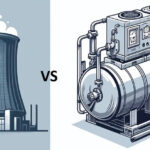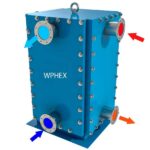Introduction
Heat transfer is a fundamental concept that plays a critical role in many scientific and engineering fields. From cooking food to powering machines, heat transfer is essential to many aspects of our daily lives. In this article, we will explore the different mechanisms of heat transfer, their applications, and their importance.
Section 1: Mechanisms
There are three primary mechanisms: conduction, convection, and radiation. This section will explain each mechanism and provide examples of their applications.
Conduction
Conduction is the transfer of heat through a material without any flow of matter. It occurs when two objects are in direct contact with each other and have different temperatures. The heat energy flows from the object with the higher temperature to the object with the lower temperature until they reach thermal equilibrium.
Conduction is more effective in materials with high thermal conductivity, such as metals. It is also dependent on the thickness of the material, with thicker materials providing more resistance to heat transfer.
Examples of conduction in everyday life include cooking on a stove, where the heat is transferred from the hot burner to the pot through conduction. Another example is holding a cold beverage in a warm room, where the heat from your hand is transferred to the beverage through conduction.
Convection
Convection is the transfer of heat through a fluid (liquid or gas) by the movement of the fluid itself. This occurs when there is a temperature difference between different parts of the fluid. As the warmer parts of the fluid rise, they are replaced by cooler parts, creating a circulation pattern.
Convection can occur naturally or artificially. Natural convection occurs in fluids that are heated from below, such as boiling water, where the warmer water rises to the top and cooler water sinks to the bottom. Artificial convection can be created through the use of fans or pumps, which move the fluid around.
Examples of convection in everyday life include heating a room with a heater, where the warm air rises and circulates around the room. Another example is boiling water on a stove, where the hot water rises to the top and cooler water sinks to the bottom.
Radiation
Radiation is the transfer of heat through electromagnetic waves. It does not require any medium for heat transfer and can occur in a vacuum. Radiation occurs when an object with a higher temperature emits electromagnetic waves, which are absorbed by an object with a lower temperature.
The amount of radiation emitted by an object depends on its temperature and surface area. Objects with higher temperatures emit more radiation, and larger surface areas increase the amount of radiation emitted.
Examples of radiation in everyday life include the warmth felt from the sun on a sunny day, and the heat emitted by a fire or a lightbulb. The heat felt from a warm object when standing close to it is also an example of radiation.
Understanding the mechanisms of heat transfer is crucial for many engineering applications, such as designing efficient cooling systems or developing insulation materials.
Section 2: Applications
Heat transfer is involved in many everyday applications, including cooking, heating and cooling buildings, and transportation. This section will provide examples of heat transfer in these applications and how they are crucial to modern life.
- Cooking: Heat transfer is essential for cooking food. Conduction and convection are the primary mechanisms of heat transfer used in cooking. In conduction, heat is transferred from the heat source to the food through direct contact. Examples of conduction in cooking include frying an egg on a hot pan or baking bread in an oven.
In convection, heat is transferred through a fluid, such as air or water. Examples of convection in cooking include roasting a chicken in an oven, where hot air circulates around the food, or boiling vegetables in water, where the heat is transferred to the vegetables through the water.
- Heating and cooling buildings: Heat transfer plays a critical role in heating and cooling buildings. Heat is transferred from the warmer indoor environment to the colder outdoor environment during the winter, and the opposite occurs during the summer. Heat can be transferred through conduction, convection, and radiation.
Insulation is used to reduce heat transfer through conduction, such as in walls and windows. Air conditioning and heating systems use convection to transfer heat between the indoor and outdoor environments. Radiant heating and cooling systems use radiation to transfer heat.
- Transportation: Heat transfer is crucial in transportation, particularly in the operation of cars, airplanes, and other vehicles. Engines generate heat that needs to be dissipated to prevent overheating. Heat is transferred through conduction, convection, and radiation.
Cooling systems, such as radiators in cars, use convection to transfer heat from the engine to the surrounding air. Airplanes use convection to regulate the temperature inside the cabin. Heat shields and exhaust systems in cars and rockets use radiation to dissipate heat.
Understanding the different applications of heat transfer is important for designing more efficient and effective systems in various fields. By optimizing heat transfer, we can increase energy efficiency, reduce waste, and improve performance.
Section 3: Importance
Heat transfer is an essential concept in many scientific and engineering fields. This section will discuss the importance of heat transfer and its impact on our lives.
- Energy efficiency: Heat transfer is essential for energy efficiency in buildings, vehicles, and machines. We will discuss how heat transfer can improve energy efficiency and reduce energy consumption.
- Climate change: Heat transfer is also involved in climate change. We will discuss how changes in heat transfer can impact global temperatures and contribute to climate change.
Conclusion
Heat transfer is a fundamental concept that is essential to many aspects of our lives. By understanding the different mechanisms of heat transfer and their applications, we can appreciate the importance of heat transfer and its impact on our world.











